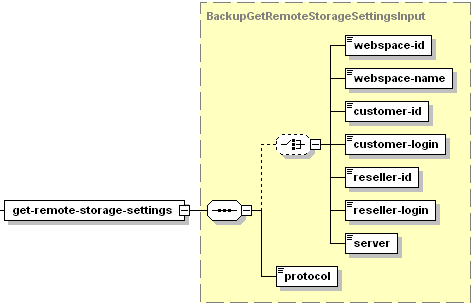Retrieving Remote Storage Settings
Use the get-remote-storage-settings operation to retrieve settings of a remote backups FTP storage.
Request Packet Structure
A request XML packet retrieving remote storage settings includes the get-remote-storage-settings operation node:
<packet>
<backup-manager>
<get-remote-storage-settings>
...
</get-remote-storage-settings>
</backup-manager>
</packet>
The get-remote-storage-settings node is presented by type
BackupGetRemoteStorageSettingsInput (backup.xsd), and its
graphical representation is as follows:

- The webspace-id node is optional. It specifies a subscription ID. Data type: integer.
- The webspace-name node is optional. It specifies a subscription name. Data type: string.
- The customer-id node is optional. It specifies a customer ID. Data type: integer.
- The customer-login node is optional. It specifies a customer login. Data type: string.
- The reseller-id node is optional. It specifies the reseller ID. Data type: integer.
- The reseller-login node is optional. It specifies a reseller login. Data type: string.
- The server node is optional. It instructs Plesk to create a server-level backup. Data type: none.
- The protocol node is required. It specifies a protocol for which the settings are retrieved. Data type: string. Allowed values: ftp.
Note: If you do not define a target Plesk user, the operation will use packet sender identifier.
Note: When creating request packets, put nodes and elements in the order they follow in the packet structure.
Note: The interactive schema navigator for all request packets is available here: http://plesk.github.io/api-schemas/1.6.8.0/agent_input.svg.
Response Packet Structure
The get-remote-storage-settings node of the output XML packet is
presented by type BackupGetRemoteStorageSettingsOutput
(backup.xsd) and structured as follows:

- The result node is required. It wraps the response retrieved
from the server. Data type: resultType (
common.xsd). - The status node is required. It specifies the execution status of the operation. Data type: string. Allowed values: ok | error.
- The errcode node is optional. Is returns the error code if the operation fails. Data type: integer.
- The errtext node is optional. It returns the error message if the operation fails. Data type: string.
- The settings node is optional. It specifies settings of a
remote storage if the operation succeeds. Data type:
BackupRemoteStorage (
backup.xsd). For details on the node, refer to the Remote Storage Settings section.
Note: The interactive schema navigator for all response packets is available here: http://plesk.github.io/api-schemas/1.6.8.0/agent_output.svg.
Samples
Retrieving remote storage settings for a customer account
This request packet retrieves remote storage settings for the customer account with ID 17.
<packet>
<backup-manager>
<get-remote-storage-settings>
<customer-id>17</customer-id>
<protocol>ftp</protocol>
</get-remote-storage-settings>
</backup-manager>
</packet>
Response:
<packet version="1.6.7.0">
<backup-manager>
<get-remote-storage-settings>
<result>
<status>ok</status>
<settings>
<protocol>ftp</protocol>
<host>ftp.example.com</host>
<port>113</port>
<directory>/backups/</protocol>
<login>myftplogin</login>
<password>myftppassword</password>
<passive-mode>false</passive-mode>
</settings>
</result>
</get-remote-storage-settings>
</backup-manager>
</packet>
If the settings haven’t been specified, the response from the server is as follows:
<packet version="1.6.7.0">
<backup-manager>
<get-remote-storage-settings>
<result>
<status>ok</status>
<settings>
<protocol>ftp</protocol>
<host>false</host>
<port>21</port>
<directory>false</directory>
<login>false</login>
<password>false</password>
<passive-mode>false</passive-mode>
</settings>
</result>
</get-remote-storage-settings>
</backup-manager>
</packet>
A negative response from the server can look as follows:
<packet version="1.6.7.0">
<backup-manager>
<get-remote-storage-settings>
<result>
<status>error</status>
<errcode>1013</errcode>
<errtext>client does not exist</errtext>
</result>
</get-remote-storage-settings>
</backup-manager>
</packet>